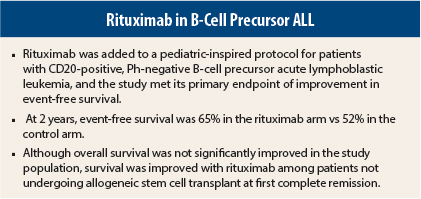The addition of rituximab (Rituxan) to the pediatric-inspired chemotherapy protocol for B-cell precursor acute lymphoblastic leukemia (ALL) significantly improved event-free survival in a large European study presented at the 2015 ASH Annual Meeting.1 The GRAALL-R 2005 phase III study is the first randomized study evaluating the role of rituximab in this population.
“In our experience, about one-third of patients with B-cell precursor ALL have CD20-positive ALL, and in these patients, the addition of rituximab is well tolerated, significantly improves event-free survival, and also prolongs overall survival in patients not receiving allogeneic stem cell transplant,” said Sébastien Maury, MD, of Höpital Henri-Mondor in Créteil, France, who presented the findings at the ASH Plenary Session on behalf of the Group for Research in adult ALL.
The population included patients with Philadelphia chromosome (Ph)-negative, CD20-positive B-cell precursor ALL. “Adding rituximab to standard therapy should become a standard of care for these patients,” Dr. Maury suggested.
The anti-CD20 monoclonal antibody rituximab has significantly improved the treatment of B-cell non-Hodgkin lymphoma and mature B-cell ALL. C20 is also expressed at diagnosis in 30%–40% of patients with B-cell precursor—and confers a worse prognosis. European researchers hypothesized that the drug may work in this malignancy as well.
Study Results
The multicenter randomized GRAALL-R 2005 trial evaluated the potential benefit of adding rituximab to the pediatric-inspired GRAALL protocol.2 The study included 220 patients aged 18–59 with newly diagnosed CD20-positive Ph-negative B-cell precursor ALL. CD20 positivity was defined as the expression of CD20 in more than 20% leukemia blasts.
Rituximab (375 mg/m2) was given for a total of 16–18 infusions from induction to maintenance. Allogeneic stem cell transplantation was offered in first complete remission to patients with one or more conventional high-risk features. The primary endpoint was event-free survival.
Event-Free Survival Improved
The modified intent-to-treat analysis included 209 patients (median age, 40 years). Treatment arms were well balanced for patient and disease characteristics.
Within a median follow-up of 30 months, patients treated with rituximab had a significantly lower cumulative incidence of relapse vs controls: 18% at 2 years, vs 30.5% (P = .029). No significant differences were observed in nonrelapse mortality, which at 2 years was 12% in each arm, Dr. Maury reported. Therefore, the study met its primary endpoint, with event-free survival rates at 2 years being 65% in the rituximab arm vs 52% in the control arm (HR = 0.66; P = .038).
Survival Benefit in Nontransplant Patients
Overall survival, however, was not significantly improved with rituximab—71% at 2 years vs 64% in the control arm (HR = 0.70; P = .095)—at least in the whole population. However, when patients who received allogeneic stem cell transplant in first complete remission were censored at the time of transplant, resulting in an analysis limited to patients who did not have transplant, overall survival was significantly prolonged with rituximab, Dr. Maury reported.
With these patients censored, 2-year overall survival was 74% with rituximab plus chemotherapy and 63% with chemotherapy alone (HR = 0.55; P = .018). Event-free survival rates were 66% and 53%, respectively (HR = 0.59; P = .021). A greater proportion of patients in the rituximab arm underwent allogeneic stem cell transplant (34% vs 20%; P = .029).
Other factors impacting event-free survival were age, involvement of the central nervous system (CNS), and white blood cell count at diagnosis. In particular, risk was essentially doubled in patients with CNS disease and an elevated white blood cell count, even after adjustment for stem cell transplant.
Adverse Reactions
Infection-related serious adverse events in nontransplanted patients numbered 71 in the rituximab arm and 55 in the control arm, which were not significantly different.
Interestingly, fewer hypersensitivity reactions to asparaginase (a component of treatment) occurred in the rituximab arm, suggesting there could be a protective effect of rituximab via suppression of B cells producing anti-asparaginase antibodies. ■
Disclosure: Dr. Maury reported no potential conflicts of interest.
References
1. Maury S, Chevret S, Thomas X, et al: Addition of rituximab improves the outcome of adult patients with CD20-positive, Ph-negative, B-cell precursor acute lymphoblastic leukemia: Results of the randomized Graall-R 2005 study. 2015 ASH Annual Meeting. Plenary Session. Abstract 1. Presented December 6, 2015.
2. Huguet F, Leguay T, Raffoux E, et al: Pediatric-inspired therapy in adults with Philadelphia chromosome-negative acute lymphoblastic leukemia: The GRAALL-2003 study. J Clin Oncol 27:911-918, 2009.



